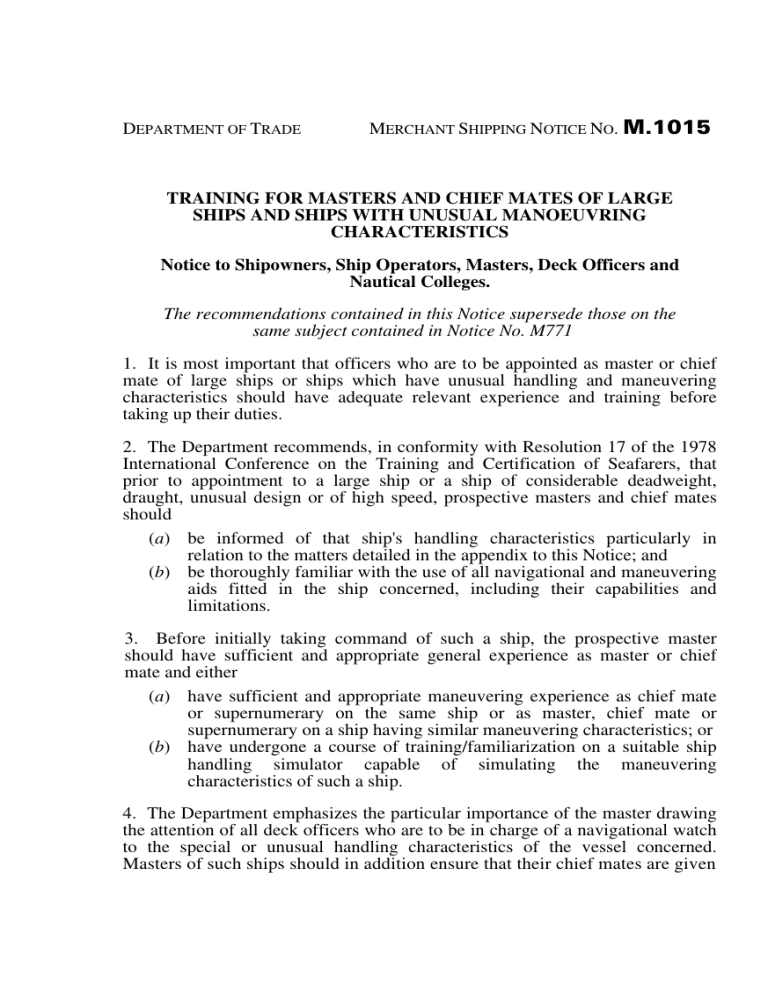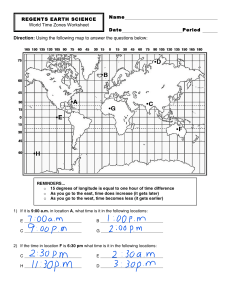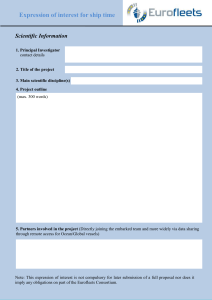MSN 1015 - Training for Masters and Chief Mates of Large Ships
advertisement

DEPARTMENT OF TRADE MERCHANT SHIPPING NOTICE NO. M.1015 TRAINING FOR MASTERS AND CHIEF MATES OF LARGE SHIPS AND SHIPS WITH UNUSUAL MANOEUVRING CHARACTERISTICS Notice to Shipowners, Ship Operators, Masters, Deck Officers and Nautical Colleges. The recommendations contained in this Notice supersede those on the same subject contained in Notice No. M771 1. It is most important that officers who are to be appointed as master or chief mate of large ships or ships which have unusual handling and maneuvering characteristics should have adequate relevant experience and training before taking up their duties. 2. The Department recommends, in conformity with Resolution 17 of the 1978 International Conference on the Training and Certification of Seafarers, that prior to appointment to a large ship or a ship of considerable deadweight, draught, unusual design or of high speed, prospective masters and chief mates should (a) be informed of that ship's handling characteristics particularly in relation to the matters detailed in the appendix to this Notice; and (b) be thoroughly familiar with the use of all navigational and maneuvering aids fitted in the ship concerned, including their capabilities and limitations. 3. Before initially taking command of such a ship, the prospective master should have sufficient and appropriate general experience as master or chief mate and either (a) have sufficient and appropriate maneuvering experience as chief mate or supernumerary on the same ship or as master, chief mate or supernumerary on a ship having similar maneuvering characteristics; or (b) have undergone a course of training/familiarization on a suitable ship handling simulator capable of simulating the maneuvering characteristics of such a ship. 4. The Department emphasizes the particular importance of the master drawing the attention of all deck officers who are to be in charge of a navigational watch to the special or unusual handling characteristics of the vessel concerned. Masters of such ships should in addition ensure that their chief mates are given opportunities to understudy and familiarize themselves with the handling and maneuvering techniques necessary in preparation for emergencies and future command. Department of Trade Marine Division London WC1V 6LP March 1982 APPENDIX SHIP HANDLING AND MANOEUVRING Manoeuvering and handling of a ship in all conditions, including: (a) maneuvers when approaching pilot vessels or stations with due regard to weather, tide, headreach and stopping distances; (b) handling a ship in rivers, estuaries, etc., having regard to the effects of current, wind and restricted water on the response to the helm; (c) maneuvering in shallow water, including the reduction in keel clearance due to the effect of squat*, rolling and pitching; (d) interaction between passing ships and between own ship and nearby banks (canal effect); (e) berthing and unberthing under various conditions of wind and tide with and without tugs; (f) choice of anchorage; anchoring with one or two anchors in limited anchorages and factors involved in determining the length of anchor cable to be used; (g) management and handling of ships in heavy weather, including assisting a ship or aircraft in distress, towing operations, means of keeping an unmanageable ship out of a sea trough, lessening drift and use of oil; (h) precautions in maneuvering for launching boats or life rafts in bad weather. * Squat: the decrease in clearance beneath a ship which occurs when the ship moves through the water and is caused both by bodily sinkage and by change of trim. The effect is accentuated in shallow water and is reduced with a reduction in ship’s speed. Dd 8248257 15,005 3/82 (18715)



